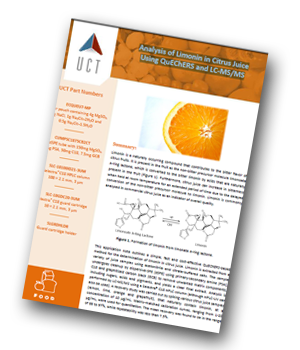UCT has produced an application note outlining a simple, fast and cost-effective QuEChERS-based method for the determination of limonin in citrus juice. Limonin is extracted from a variety of juice samples using acetonitrile and citrate-buffered salts. The sample undergoes cleanup by dispersive-SPE (dSPE) using primary-secondary amine (PSA), C18 and graphitized carbon black (GCB) to remove unwanted matrix components, including sugars, acids and pigments.
 Introduction
Introduction
Limonin is a naturally occurring compound that contributes to the bitter flavour of
citrus fruits. It is commonly analysed in commercial citrus juice as an indicator of overall quality.
Experimental
The sample undergoes cleanup by dispersive-SPE (dSPE) using primary-secondary amine (PSA),
C18 and graphitized carbon black (GCB) to remove unwanted matrix components, including sugars, acids and pigments, and yields a clear final extract. Analysis is performed by LC-MS/MS using a Selectra® C18 HPLC column (although HPLC-UV can also be used). A recovery study was carried out by spiking various citrus juice samples (lemon, lime, orange and grapefruit), that naturally contain limonin, at a concentration of 10 μg/mL. Matrix-matched calibration curves, ranging from 1-20 μg/mL, were used for quantitation. The mean recovery was found to be in the range of 88 to 97%, while repeatability was less than 7.5%.
Results and Discussion
Atmospheric pressure chemical ionization (APCI) was found to give significantly better signal response than electrospray ionization (ESI). In APCI the most intense signal response was generated in positive mode (APCI+), forming the protonated molecular ion [M+H]+ at m/z 371, whereas in ESI the most intense signal response was generated in negative mode (ESI-). Furthermore, in both APCI and ESI it was found that the use of methanol in the mobile phase generated a higher signal response compared to the use of acetonitrile, regardless of the mobile phase additive used.
Conclusion
This application note outlines a simple, fast and cost-effective QuEChERS-based method for the
determination of limonin in citrus juice. Citrus juice samples are extracted with citrate-buffered QuEChERS salts followed by dSPE cleanup of the supernatant using PSA, C18 and GCB, yielding a clear extract. Analysis is performed by LC-MS/MS using a Selectra® C18 HPLC column. Various citrus juices (lemon, lime, orange and grapefruit) were evaluated for recovery and repeatability using fortified samples. Excellent recovery (88 to 97%) and repeatability (≤ 7.5%) were obtained using the outlined method.




